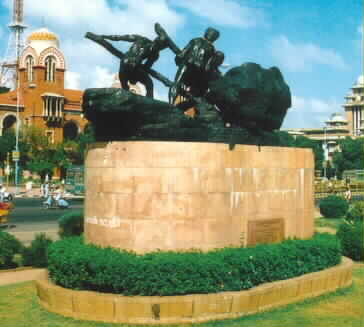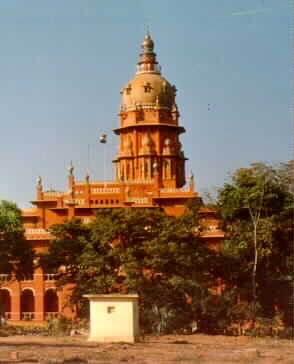BEAUTY OF CHENNAI (MADRAS)
 "Statue of Labour"
"Statue of Labour"
FORT ST. GEORGE
Built in 1640 A.D. by Francis Day for the
East India Company, it was the baston of British Power in India and fine
example of the 17 th century British Military Architecture. Today it
houses the State Legislature and Secretariat. Major building constructions
took place upto 1783. The old building still stand, and the only major
addition is of new Secretariat Multistorey building. The flag staff here
is (46 Mts high) the tallest in the country. The Museum building built
in 1790 originally had a bank on the ground floor. The Museum was opened
in 1948 and has a collection of writings,paintings,arms,coins,manuscripts
etc.
FORT MUSEUM
Arms and Uniforms,priceless documents,portraits and
sculpture,evidences of 300 years of British presence in India,are housed
in this 18 th century building within the Fort. These exhibits include
a magnificent 4.3 meter statue of Lord Cornwallis, portraits of early governors
and in the Indo- French Gallery some exquisite table clocks and Louis XIV
furniture. Of special interest is the display of Medieval weapons with
instructions on their handling; the first light house of chennai
(madras) ;30.5 meter above sea level; was situated in this building and
was in use until 1841.
MARINA BEACH
The second longest beach in the world ,the
Marina is the major attraction of Chennai. The beautiful promenade was
constructed in 1884. Coming from the Fort St.George and crossing Napier
bridge one can find broad beautiful road with wide sandy beach, and a number
of historical buildings, like the Madras University, the Chepauk Palace
and the Presidency college, All India Radio on the right and the Light
House on the left. A swimming pool on the left welcomes the visitor and
after that is the famous statue of Labour and Aquarium. The Important building
opposite is the university complex and notable for its Indo-Saracenic architecture
is the Senate House. Chepauk Palace, was built in 1768 by the Nawab of
Arcot and taken over by the British in 1855. Behind the Palace is the well
known M. A. Chidambaram Cricket stadium.
NATIONAL ART GALLERY
Adjacent to the museum on Pantheon Road is the Art
Gallery. This Gallery has fine collections of old paintings and sculptures,
the most outstanding being that of 10th-13th century bronzes now housed
in a separate rear building. Other exhibits include Tanjore Paintings,
glass in luminescent colors, Mughal and Rajput miniatures, 17th century
deccani paintings, 11th and 12th century handicrafts, carved ivory pieces
and metalware.
THEOSOPHICAL SOCIETY
From Santhome going south and crossing the Adyar
river on the left is the calm, quiet, serene headquarters of the Theosophical
Society. Inside are the shrines of all faiths a banian tree, one among
the oldest and largest in the country.The theosophical movement was
stared by Madam Blavatsky in 1875 in U.S.A along with Col. Olcott and was
brought to India in 1879 making Adayar as the world head quarters.
However the real credit for building up the movement goes to Annie Beasant,
an Irish woman who joined in 1889. The Society has been attracting serious
minded people from all walks of life from all over the world.
RIPPON BUILDING
A little to the west of central station is a palatial
white building housing the oldest city corporation in India. The Madras
corporation, the first in India, was created in 1687 by a Royal Charter
of JamesII by the order of the governor, Elihu Yale and Josiah child, the
chairman of the East India Company. The building which was constructed
in 1913,was named after Lord Rippon, a former Governor General of India.
HIGH COURT
A magnificent example of Indo-Saracenic architecture.
In 1841, a granite Doric column of 49m was erected to function  as
the second lighthouse. It was constructed on the site of the demolished
China Malleswarar temple and the China Cassava temple. The building said
to be the second largest judicial building in the world after the Courts
of London was designed by Henry Irwin. It may be of interest to know
that the place was shelled by the Germans in 1914 and a plaque commemorating
it can be seen on the eastern boundary wall.
as
the second lighthouse. It was constructed on the site of the demolished
China Malleswarar temple and the China Cassava temple. The building said
to be the second largest judicial building in the world after the Courts
of London was designed by Henry Irwin. It may be of interest to know
that the place was shelled by the Germans in 1914 and a plaque commemorating
it can be seen on the eastern boundary wall.
SNAKE PARK
Snake park is just behind the Children's Park. The
collection of reptiles is large and demonstrations are held at an interval
of every hour from 10.00 hr. onwards.It houses lizards,crocodiles and tortoises
as well as Cobras,Pythons,banded Kraits,Russel's Vipers and other kinds
of snakes.There are several exotic reptiles from South and Central America.
Venom is extracted at 17.00 hr. every Saturday and Sunday.
CROCODILE PARK
The crocodiles are left in their natural surroundings.
A large variety of reptiles are bred in captivity here. It is situated
42 kms towards Mahabalipuram.
NATIONAL PARK
Behind the Snake park and adjacent to the Governor's
residence in China,
this 231 hectares game reserve is the only one of its kind actually within
the limits of a Metropolitan city. The park's prize specimen is the Indian
Antelope or Black Buck, found only in India and only in this park. Bird
watchers will find this place rewarding.
BURL PLANETARIUM
Located in the Perrier Science and Technology Center,
The Burl Planetarium presents audio-visual programs on astronomy. A must
for lovers of astrology and students.
THE OBSERVATORY
Now called the regional meteorological centre,the
Nungambakkam observatory was established in 1792. It grow out of a private
observatory erected 10 years 10 years earlier by a scientist, William Peter.
In 1894, the astronomical observatory was shifted to Kodaikannal and the
Chennai observatory operated as a meteorological station.
KALAKSHETRA
This unique institution propagating and teaching
Carnatic Music,Bharathanatiam and other fine arts in natural surroundings
is on the Mamallapuram Road in Thiruvanmiyoor,Chennai. It was founded by
Shrimati Ruckmini Devi Arundale who was herself a great exponent of Bharathanatyam
and the president of the institution. Nearby is Maruntheeswarar Temple
a 11 th century temple built during the chola period (985-1178 A.D.)
KAPALEESWAR TEMPLE
Rebuilt 350 years ago, this Siva temple is
a classic example of Dravidian temple culture and architecture. Some special
features are the 120 ft. tall gopuram, the bronze statues of the
63 Saivite saints.
PARTHASARATHY TEMPLE
About 1500 years old,this temple in Triplicane
is the oldest temple structure in Chennai(Madras). It is one of the 108
sacred centres of Vishnu Worships and the only one dedicated to Parthasarathy.
Evidence from stone inscriptions indicates that the main temple was first
built by a Pallava King.
SANTHOME BASILICA
This church was built on the tomb of St.Thomas
containing a small a bone of the apostle and the head of the lance
with which he is said to been attacked.
ST. MARY'S CHURCH
Constructed in 1680, it is the oldest Protestant
church in India. The church has spire and a tower and is situated in
a quite tree shaded corner of Fort St.George. It preserves unbroken records.
It was here the early empire builders like Robert Clive, Elihu Yale, Corn
Wallis, Wellesley worshipped.
ARMENIAN CHURCH
Built in 1772 (to replace the one demolished in 1712),
the Armenian church of the Holy Virgin Mary stands on an old Armenian Burial
Ground. The ground was the property of Agha Shameer, who with his wife
and and their seven sons is buried under the Shameer.
VELANKANNI CHURCH (MADRAS)
This church is in honour of Lady of health, the Madonna
of Velankanni. Smaller in scale than the original one at Velankanni (near
Nagapattanam in Tamilnadu coast), the devoted belives in the curative
powers of Madonna.
BIG MOSQUE
Built in 1789 by the Nawab of Wallajah, this
mosque is surely one of the most attractive ones in south India, built
of gray granite rather than wood or steel. The unique distinction of
the mosque is the chronogram engraved in the stone done by a Hindu named
Raja Makkan Lal, a Persian and Arabic scholar.
THOUSAND LIGHTS MOSQUE
The elegant, green colored Shia Muslim mosque at
the corner of Peters Road and Anna Salai, is a major landmark in Chennai.
Its name Thousand Lights is derived from the thousand oil lamps
that used to be light at twilight in the old mosque and is now used to
describe the whole locality. The old mosque was constructed in the early
17 th Century by a member of the Wallajah Family (the Nawab of Umdat-Ul-Umrah)
in 1800.


 as
the second lighthouse. It was constructed on the site of the demolished
China Malleswarar temple and the China Cassava temple. The building said
to be the second largest judicial building in the world after the Courts
of London was designed by Henry Irwin. It may be of interest to know
that the place was shelled by the Germans in 1914 and a plaque commemorating
it can be seen on the eastern boundary wall.
as
the second lighthouse. It was constructed on the site of the demolished
China Malleswarar temple and the China Cassava temple. The building said
to be the second largest judicial building in the world after the Courts
of London was designed by Henry Irwin. It may be of interest to know
that the place was shelled by the Germans in 1914 and a plaque commemorating
it can be seen on the eastern boundary wall.